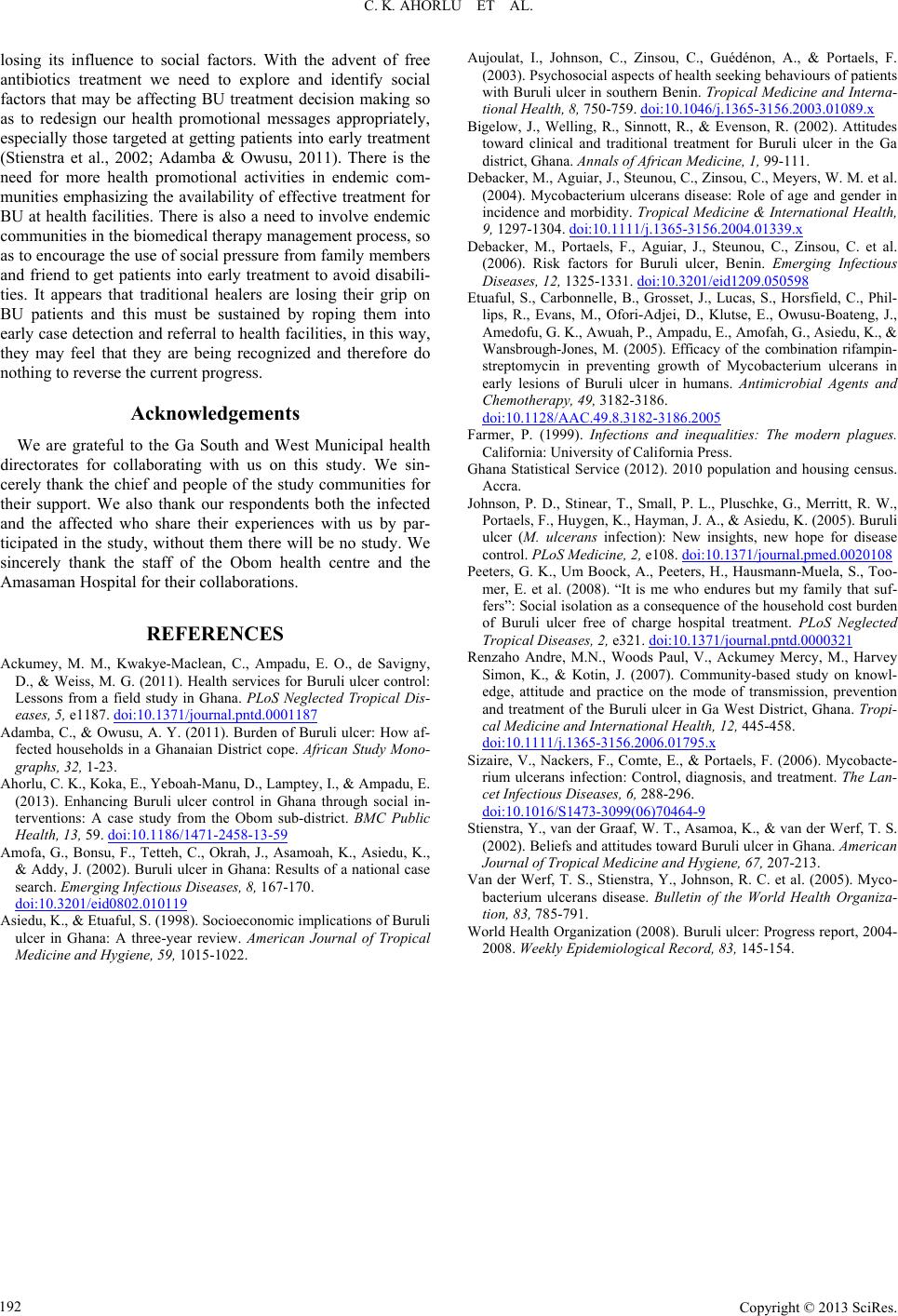
C. K. AHORLU ET AL.
Copyright © 2013 SciRes.
192
losing its influence to social factors. With the advent of free
antibiotics treatment we need to explore and identify social
factors that may be affecting BU treatment decision making so
as to redesign our health promotional messages appropriately,
especially those targeted at getting patients into early treatment
(Stienstra et al., 2002; Adamba & Owusu, 2011). There is the
need for more health promotional activities in endemic com-
munities emphasizing the availability of effective treatment for
BU at health facilities. There is also a need to involve endemic
communities in the biomedical therapy management process, so
as to encourage the use of social pressure from family members
and friend to get patients into early treatment to avoid disabili-
ties. It appears that traditional healers are losing their grip on
BU patients and this must be sustained by roping them into
early case detection and referral to health facilities, in this way,
they may feel that they are being recognized and therefore do
nothing to reverse the current progress.
Acknowledgements
We are grateful to the Ga South and West Municipal health
directorates for collaborating with us on this study. We sin-
cerely thank the chief and people of the study communities for
their support. We also thank our respondents both the infected
and the affected who share their experiences with us by par-
ticipated in the study, without them there will be no study. We
sincerely thank the staff of the Obom health centre and the
Amasaman Hospital for their collaborations.
REFERENCES
Ackumey, M. M., Kwakye-Maclean, C., Ampadu, E. O., de Savigny,
D., & Weiss, M. G. (2011). Health services for Buruli ulcer control:
Lessons from a field study in Ghana. PLoS Neglected Tropical Dis-
eases, 5, e1187. doi:10.1371/journal.pntd.0001187
Adamba, C., & Owusu, A. Y. (2011). Burden of Buruli ulcer: How af-
fected households in a Ghanaian District cope. African Study Mono-
graphs, 32, 1-23.
Ahorlu, C. K., Koka, E., Yeboah-Manu, D., Lamptey, I., & Ampadu, E.
(2013). Enhancing Buruli ulcer control in Ghana through social in-
terventions: A case study from the Obom sub-district. BMC Public
Health, 13, 59. doi:10.1186/1471-2458-13-59
Amofa, G., Bonsu, F., Tetteh, C., Okrah, J., Asamoah, K., Asiedu, K.,
& Addy, J. (2002). Buruli ulcer in Ghana: Results of a national case
search. Emerging Infectious Diseases, 8, 167-170.
doi:10.3201/eid0802.010119
Asiedu, K., & Etuaful, S. (1998). Socioeconomic implications of Buruli
ulcer in Ghana: A three-year review. American Journal of Tropical
Medicine and Hygiene, 59, 1015-1022.
Aujoulat, I., Johnson, C., Zinsou, C., Guédénon, A., & Portaels, F.
(2003). Psychosocial aspects of health seeking behaviours of patients
with Buruli ulcer in southern Benin. Tropical Medicine and Interna-
tional Health, 8, 750-759. doi:10.1046/j.1365-3156.2003.01089.x
Bigelow, J., Welling, R., Sinnott, R., & Evenson, R. (2002). Attitudes
toward clinical and traditional treatment for Buruli ulcer in the Ga
district, Ghana. Annals of African Medicine, 1, 99-111.
Debacker, M., Aguiar, J., Steunou, C., Zinsou, C., Meyers, W. M. et al.
(2004). Mycobacterium ulcerans disease: Role of age and gender in
incidence and morbidity. Tropical Medicine & International Health,
9, 1297-1304. doi:10.1111/j.1365-3156.2004.01339.x
Debacker, M., Portaels, F., Aguiar, J., Steunou, C., Zinsou, C. et al.
(2006). Risk factors for Buruli ulcer, Benin. Emerging Infectious
Diseases, 12, 1325-1331. doi:10.3201/eid1209.050598
Etuaful, S., Carbonnelle, B., Grosset, J., Lucas, S., Horsfield, C., Phil-
lips, R., Evans, M., Ofori-Adjei, D., Klutse, E., Owusu-Boateng, J.,
Amedofu, G. K., Awuah, P., Ampadu, E., Amofah, G., Asiedu, K., &
Wansbrough-Jones, M. (2005). Efficacy of the combination rifampin-
streptomycin in preventing growth of Mycobacterium ulcerans in
early lesions of Buruli ulcer in humans. Antimicrobial Agents and
Chemotherapy, 49, 3182-3186.
doi:10.1128/AAC.49.8.3182-3186.2005
Farmer, P. (1999). Infections and inequalities: The modern plagues.
California: University of California Press.
Ghana Statistical Service (2012). 2010 population and housing census.
Accra.
Johnson, P. D., Stinear, T., Small, P. L., Pluschke, G., Merritt, R. W.,
Portaels, F., Huygen, K., Hayman, J. A., & Asiedu, K. (2005). Buruli
ulcer (M. ulcerans infection): New insights, new hope for disease
control. PLoS Medicine, 2, e108. doi:10.1371/journal.pmed.0020108
Peeters, G. K., Um Boock, A., Peeters, H., Hausmann-Muela, S., Too-
mer, E. et al. (2008). “It is me who endures but my family that suf-
fers”: Social isolation as a consequence of the household cost burden
of Buruli ulcer free of charge hospital treatment. PLoS Neglected
Tropical Diseases, 2, e321. doi:10.1371/journal.pntd.0000321
Renzaho Andre, M.N., Woods Paul, V., Ackumey Mercy, M., Harvey
Simon, K., & Kotin, J. (2007). Community-based study on knowl-
edge, attitude and practice on the mode of transmission, prevention
and treatment of the Buruli ulcer in Ga West District, Ghana. Tropi-
cal Medicine and International Health, 12, 445-458.
doi:10.1111/j.1365-3156.2006.01795.x
Sizaire, V., Nackers, F., Comte, E., & Portaels, F. (2006). Mycobacte-
rium ulcerans infection: Control, diagnosis, and treatment. The Lan-
cet Infectious Diseases, 6, 288-296.
doi:10.1016/S1473-3099(06)70464-9
Stienstra, Y., van der Graaf, W. T., Asamoa, K., & van der Werf, T. S.
(2002). Beliefs and attitudes toward Buruli ulcer in Ghana. American
Journal of Tropical M e dicine and Hygiene, 67, 207-213.
Van der Werf, T. S., Stienstra, Y., Johnson, R. C. et al. (2005). Myco-
bacterium ulcerans disease. Bulletin of the World Health Organiza-
tion, 83, 785-791.
World Health Organization (2008). Buruli ulcer: Progress report, 2004-
2008. Weekly Epidemiological Re c or d , 8 3 , 145-154.